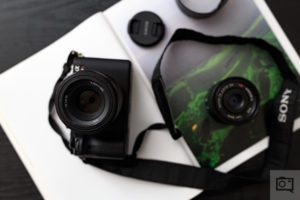
In a low-light situation with a split-second to focus and capture the moment, the flashgun's AF illuminator was essential. Mirrorless cameras tend not to offer this feature and their AF systems aren't so good in low light that they don't need it.
24mm F1. 4 lens @ F2 | ISO 400
Photo: Rishi Sanyal
Mirrorless cameras have caught up with DSLRs in almost every measurable respect, yet there's still one feature that's essential for some professionals that every one of them lacks: flash AF illumination.
The failure to offer an AF illuminator target means mirrorless can't compete with the best DSLRs in some shooting situations
Wedding and event photographers in particular will recognize the benefit of the AF assist target projected by flashguns and some flash commander units, yet no mirrorless camera maker implements this feature, even on their highest-end models. There are some technical reasons why they omit the feature, but this doesn't negate the need for it.
'IR' illuminators on flashguns aren't solely emitting infra-red: they also emit visible red light, or you wouldn't be able to see their telltale grid pattern
It won't affect everybody's day-to-day photography, but the near-universal failure to offer some sort of flash AF illuminator target for mirrorless cameras remains a major shortcoming and means mirrorless can't compete with the best DSLRs in some shooting situations.
There are technical justifications for why they don't: DSLR autofocus sensors can be sensitive to infra-red light, whereas mirrorless cameras aren't. Because mirrorless cameras focus using their main imaging sensor, any IR has to be filtered-out to avoid skewing the colors in your images. But the AF illuminators on flashguns aren't solely emitting infra-red: they also emit lots of visible red light, otherwise you wouldn't be able to see the telltale red grid they project.
Note that the 'IR' illuminator in this instance is projecting a visible red target and, crucially, a target that provides a pattern for the camera's AF system to bite onto.
Another complication is that phase-detection pixels live behind the colored filters that allow most cameras to interpret color in the scene, so may not even see any red light. A PDAF element behind a blue filter won't see any red light and one behind a green filter will only see a very small amount. But even this shouldn't be insurmountable: Canon's Dual Pixel AF means every pixel (including the red-sensitive ones) is a PDAF pixel and, if it came down to it, the manufacturers could offer versions of their flashguns that emit a color that their mirrorless AF systems can see.
If mirrorless cameras are going to displace DSLRs for wedding and event photography, manufacturers need to find a way
Most mirrorless cameras have their own built-in AF illuminators but they're not nearly as powerful as the off-board lamps on flashguns. Also, they tend to be bright, uniform orange or green lamps which are visually distracting, easily blocked by hands or large lenses and which miss one of the key properties of off-board illuminators: a grid pattern. This grid pattern effectively creates some hard-edges for the AF system to bite onto, even if you're shooting something that may not have enough inherent contrast to easily focus on. You know, like a white wedding dress in low light.
If mirrorless cameras are going to displace DSLRs for wedding and event photography, manufacturers need to find a way, even if it involves selling (or modifying) flash units that emit a faint green or blue grid pattern. Or doing what Godox does with its X1T command units: firing its red target, just as it would for DSLRs, because in many cases this is better than nothing.
. dpreview.com2018-10-27 20:00









